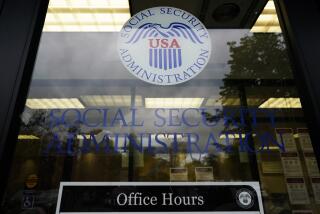A SURPRISE PLUCKING : Loss of Deductions, Shelter Benefits Begin to Take a Toll From Some Taxpayers
- Share via
Most Americans will pay fewer taxes this year, thanks to tax reform. But Norm Zareski won’t be one of them.
Due in part to losing several key tax deductions and reduced tax shelter benefits, the 49-year-old computer sales executive from Palos Verdes Estates last week discovered--to his surprise--that the total tax liability for him and his wife will jump sixfold, to about $27,000 from $4,300 last year. This is despite little change in their income.
“It’s shocking to look at the difference,” says Zareski, who will have to dip into savings, sell shares in a mutual fund and scale back celebrating his 25th wedding anniversary to pay the tax bill. “We’ve always handled our money conservatively, never getting into big debts, and all of a sudden this surprise. . . . It just got away from us this year.”
The Zareskis are among many Americans completing their returns now and discovering to their dismay that their tax bills are higher, not lower, often because of loss of key deductions, quirks in tax rates or other factors.
Some--particularly high-income individuals with tax shelters--were forewarned by their accountants of higher tax bills and thus are taking the news in stride. For them, reduced benefits for tax shelters and real estate, among other things, more than offset declines in tax rates.
But others--particularly those middle-income taxpayers with an untimely set of deductions rolled back under tax reform--are angry. They had been led to believe that the new law would generally result in lower taxes for individuals and higher taxes for corporations.
These taxpayers’ ire--coming on top of confusion and anxiety over the complexity of the new law and new tax forms--could reduce support for tax reform and result in the reinstatement of key tax breaks or other changes.
“People feel conned,” says Sidney Kess, partner with the accounting firm of Peat Marwick Main & Co. “Everybody was led to believe taxes would be going down.”
Indeed, most people are expected to pay lower taxes for 1987 returns, thanks largely to lower tax rates.
The congressional Joint Committee on Taxation estimated in October, 1986--when tax overhaul was passed--that only 18.5% of all taxpayers would pay more tax for 1987 returns, compared to the previous year.
That percentage declines for lower-income taxpayers. Only 12.2% of those with annual adjusted gross incomes under $10,000 will pay more this year, the committee estimated. By contrast, 53.7% of those with adjusted gross incomes between $75,000 and $100,000 were expected to pay more tax.
A much higher percentage of taxpayers may perceive--possibly incorrectly--that their taxes will be higher this year. A Washington Post-ABC News poll released last week, for example, shows that nearly six in 10 taxpayers expect to pay more this year.
But these taxpayers may believe they are paying more only because their refunds are lower. Indeed, many taxpayers incorrectly adjusted their withholding on W-4 forms last year, resulting in severe cases of over-withholding or under-withholding. Those who were under-withheld may be socked with large additional tax due on April 15 instead of getting refunds as they normally expect. However, their total tax liability actually may have declined.
Many of those taxpayers with lower bills do not itemize deductions and thus are not touched by tax reform’s closing of various loopholes and writeoffs.
Others are lowering their taxes by using what few tax breaks are preserved under tax reform. Karen Hew, 26, an accountant in Rancho Santa Margarita, says she cut her taxes simply because she bought a house recently and is taking a deduction for mortgage interest for the first time.
Little Advance Warning
But higher taxes are coming as a shock to many individuals, particularly middle-income taxpayers who prepare their own returns and thus were not forewarned by accountants or other financial experts that tax changes would affect them adversely. Many of these higher-tax individuals are only beginning to fill out returns now; those who expected lower tax bills, or higher refunds, tended to file earlier.
However, even some taxpayers who use professional preparers have been surprised by higher bills. They had little advance warning because their practitioners have been snowed under, far behind in processing returns because of glitches in computer tax software, delays in receiving K-1 income-statement forms from limited partnerships and simple frustration.
“It’s extremely annoying,” says a UC Berkeley professor who prepares his own taxes on his computer and claims to have studied the new law diligently, only to be surprised that his taxes will go up about $5,000 this year.
Some lower-income taxpayers appear to be victims of quirks in tax rates. Louis Gettleson, a 72-year-old retired Chatsworth store owner, figured there was no way his taxes should go up much, because his taxable income of about $8,500 didn’t change much from the year before, and he doesn’t itemize.
But due to a quirk in tax rates, in which his income is taxed between 11% and 15% this year versus between 0% and 14% last year, Gettleson’s tax bill will double, to about $1,151 from $559.
“I don’t think it’s right,” he says. “They should make provisions for the little guy.”
Perhaps the most likely group of middle-income taxpayers to be hit with higher taxes will be those with an unfortunate combination of writeoffs rolled back under tax reform.
Couples with both spouses working, for example, may lose $7,000 in deductions right off the bat. First, the two-earner deduction for working spouses, worth up to $3,000 in deductions, has been repealed. Second, each spouse may lose $2,000 in writeoffs for contributions to individual retirement accounts, which are no longer deductible for higher-income individuals covered by qualified company retirement plans.
These people may also pay more tax because of the reduced deductibility of miscellaneous expenses such as union dues, professional education expenses and unreimbursed employee expenses. Those expenses can now be deducted only to the extent that they exceed 2% of adjusted gross income.
Also no longer deductible are state sales taxes. Non-mortgage consumer interest, such as for credit cards and auto loans, is only 65% deductible for 1987 returns, versus 100% before.
Ernest Jewell, a 52-year-old management consultant from Fullerton, is a victim of these lost tax breaks. His sizable credit card and auto loans are no longer fully deductible. Jewell also bought a car last year and can no longer deduct sales tax.
Writeoffs Lost
The loss of those deductions “hurts like crazy,” Jewell says, adding that he expects to owe an additional $10,000 to $15,000 in tax on April 15. Fortunately, he says, he will get an automatic two-month extension on paying it because he will be out of the country on April 15 while on a 2 1/2-week business trip to Argentina and Mexico.
Andy Armes, a 38-year-old registered nurse from Atascadero, Calif., also is losing key deductions. He and his wife, Trudy, a 38-year-old psychiatric technician, have lost the writeoffs for working spouses and IRAs. And they can write off only a portion of their continuing education costs, union dues, professional journal subscriptions and other miscellaneous deductions.
“We don’t get any kind of advantage from the new tax changes at all,” Armes complains, saying that the loss of these and other deductions would have boosted his tax bill by $7,000 to $9,000. Fortunately, he says, he and his wife recently bought a more expensive home, and their larger mortgage deductions just barely offset reduced deductions from other sources. So his overall tax liability will be slightly less than last year.
Unfortunately, it’s too late for taxpayers facing higher tax bills for 1987 returns to do much to reduce them retroactively. Some can still put money into IRAs before April 15, but many higher-income individuals can’t deduct those contributions any more.
Options available to cut taxes for next year and beyond also are hard to come by. For example, limited partnerships that produce high writeoffs--once popular as tax shelters--have been virtually killed by tax reform.
“The house has been cleaned,” says Judith Martindale, a San Luis Obispo financial planner. “There aren’t many choices.”
Still, some choices remain. Martindale has some clients buying single-premium deferred annuities, in which they make a large lump-sum payment into a fund that will accumulate earnings tax-deferred until withdrawn in later years.
Stephanie Enright, a Torrance financial planner, has clients refinancing their homes to increase mortgage interest deductions and provide funds for other investments. Other clients are making investments in low-income housing, which provide tax credits, Enright says.
Jim Hamill, a Woodland Hills accountant, says some of his clients are considering putting their children’s money into tax-free bonds. That could reduce the jolt of the new “kiddie tax,” in which non-wage income above $1,000 earned by children under 14 is taxed at their parents’ rate.
Bigger Mortgages Help
Registered nurse Armes and his wife are boosting contributions into their company 401(k) savings plans, which will reduce their taxable income while building a nest egg for retirement. They also are considering buying a second home to increase mortgage interest deductions.
Computer sales executive Zareski says his wife, Susan, a professor of nursing, may hike her contributions to a tax-sheltered annuity. They also are considering renovating their home and paying for it with a second mortgage, which would boost their interest deductions. A bigger house may also be a possibility.
But, unfortunately, these options also involve shelling out more cash--which could add more risk and frustration as well.
“I’d hate to think of having to buy a bigger house just to reduce taxes,” Zareski says. “If my income diminishes, I could get squeezed on cash flow.”
10 COMMON DEDUCTIONS NOW CURTAILED
* Two-earner deduction of up to $3,000 for couples with both spouses working has been repealed.
* Individual retirement accounts are no longer deductible for certain high-income taxpayers with company retirement plans.
* Miscellaneous deductions such as union dues, unreimbursed employee expenses and professional journal subscriptions are deductible only to the extent they exceed 2% of adjusted gross income.
* Medical expenses are deductible only to the extent they exceed 7.5% of adjusted gross income.
* Non-mortgage consumer interest is only 65% deductible for 1987 returns.
* Charitable contributions are deductible only for itemizers.
* Sales tax is no longer deductible.
* Business-related meal and entertainment expenses are only 80% deductible.
* Losses from limited partnerships and rental properties generally are no longer fully deductible against income from wages, dividends and capital gains.
* Dividend exclusion of $200 repealed.
More to Read
Inside the business of entertainment
The Wide Shot brings you news, analysis and insights on everything from streaming wars to production — and what it all means for the future.
You may occasionally receive promotional content from the Los Angeles Times.










